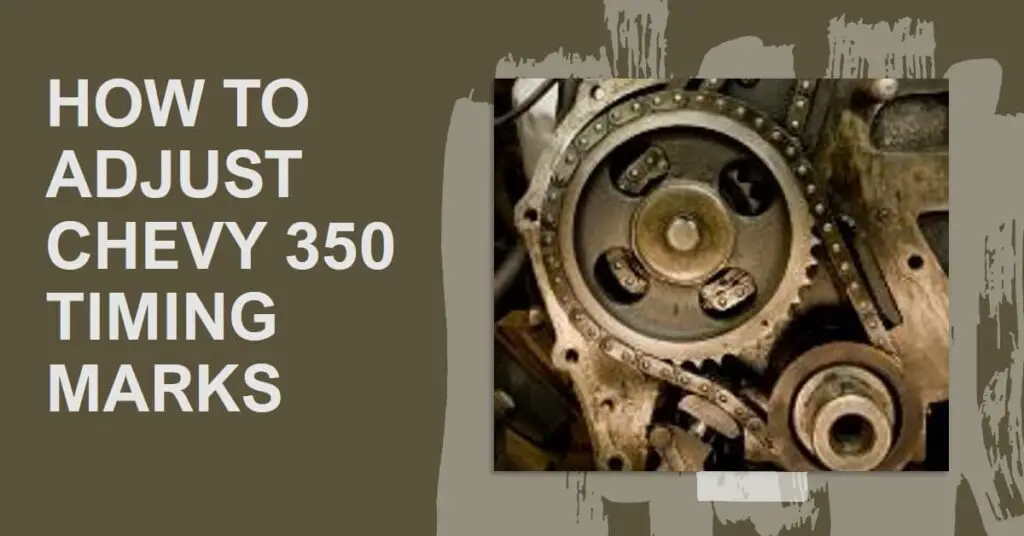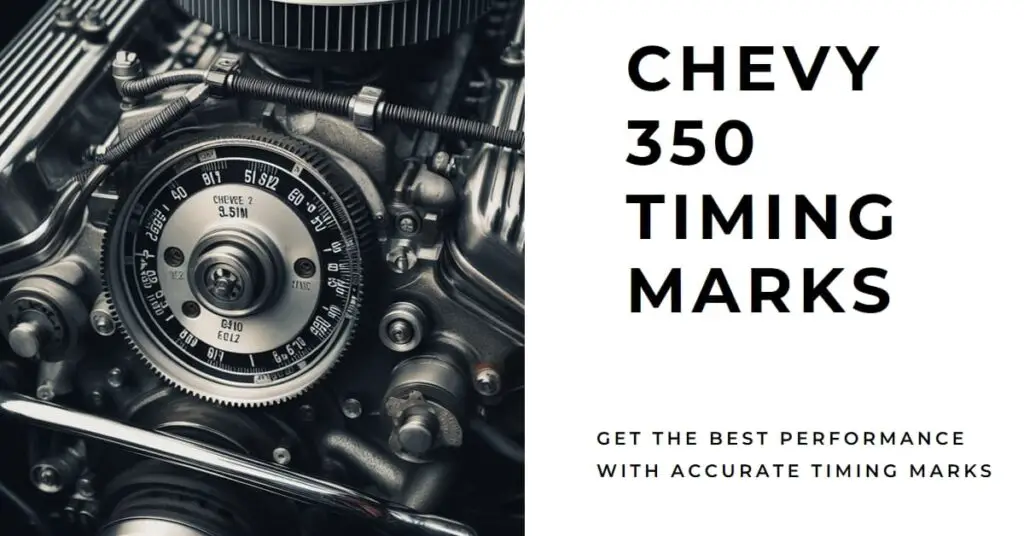As someone who’s been elbow-deep in engine grease more times than I can count, I’m here to guide you through Setting the timing marks on a Chevy 350 engine.
Whether you’re a seasoned gearhead or a newbie with a wrench, understanding timing marks on your Chevy 350 is crucial.
In this guide, I’ll walk you through the steps to adjust Chevy 350 Timing Marks and troubleshoot it.
What are Chevy 350 Timing Marks?
Chevy 350 timing marks are reference points on the engine’s crankshaft and camshaft gears. These marks ensure the engine’s valves open and close at the correct times during each cylinder’s intake and exhaust strokes, which is crucial for optimal engine performance and efficiency.
For a practical approach to setting your Chevy 350’s timing without a timing light, delve into my guide here.
Locating Chevy 350 Timing Marks
Follow these steps to locate Chevy 350 Timing Marks:
- Identify the Crankshaft Pulley: Look for the crankshaft pulley at the front of the engine; it will have a visible notch or line.
- Find the Timing Chain Cover: This cover, located near the crankshaft pulley, has degree markings for timing.
- Align the Marks: Rotate the crankshaft to align the notch on the pulley with the “0” degree mark on the timing chain cover.
- Top Dead Center (TDC): This alignment sets the engine at TDC for the number one cylinder, a crucial step for accurate timing.
- Use a Timing Light: For precise timing, use a timing light to ensure proper alignment while the engine is running.
- Adjust as Needed: If the marks don’t align, adjust the timing by rotating the distributor slightly.
- Check Manufacturer Specifications: Always refer to Chevy’s specifications for exact timing settings.
- Regular Maintenance: Regularly check and adjust timing to maintain engine efficiency and performance.
For optimal performance of your Chevy 350, don’t forget to check out my guide on the Best Spark Plugs for Chevy 350.
How to Adjust Chevy 350 Timing Marks

Follow these steps to set Chevy 350 Timing Marks:
- Warm Up the Engine: Start the engine and let it run until it reaches its normal operating temperature.
- Turn Off the Engine: Shut off the engine and disconnect the vacuum advance hose from the distributor, if applicable. Plug the hose to prevent air leaks.
- Locate Timing Marks: Find the timing marks on the crankshaft pulley and the timing scale on the engine.
- Set Engine to Top Dead Center (TDC): Rotate the crankshaft pulley so the “0” on the pulley aligns with the “0” on the timing scale. This sets the engine to TDC for the number one cylinder.
- Connect Timing Light: Hook up a timing light to the number one spark plug wire. The timing light will flash each time the number one cylinder fires, illuminating the timing marks.
- Start the Engine: Restart the engine and aim the timing light at the timing marks. Observe where the pulley mark aligns with the timing scale.
- Adjust the Distributor: If the timing is off, loosen the distributor hold-down clamp just enough to allow rotation. Rotate the distributor slowly to adjust the timing. Clockwise rotation will advance the timing, while counterclockwise will retard it.
- Recheck Timing: After each adjustment, use the timing light to check the alignment of the marks. Continue adjusting until the desired timing is achieved.
- Tighten Distributor Clamp: Once the timing is correctly set, securely tighten the distributor hold-down clamp.
- Reconnect Vacuum Advance: Reconnect the vacuum advance hose to the distributor.
- Final Check: Rev the engine a few times and recheck the timing to ensure it remains correct under different RPMs.
- Turn Off Engine and Remove Timing Light: After adjusting, turn off the engine and remove the timing light and other tools.
Explore our insights on resolving Chevy Starter Engagement Problems for more solutions to keep your vehicle in top condition.
What Should the Timing Be Set at On a Chevy 350?
The timing on a Chevy 350 engine should be set at around 4 to 12 degrees before top dead center (BTDC) for initial timing.
Assessing Chevy 350 Timing Marks for Engine Health
This is how you can use timing marks for engine health assessment:
- Consistent Mark Alignment: Properly aligned timing marks indicate good synchronization between the crankshaft and camshaft. Inconsistent or off-mark alignment suggests timing issues, potentially due to a worn timing chain or gear.
- Engine Response and Idle: Observe the engine’s response after setting the timing. A well-timed engine should run smoothly with a steady idle. Rough idling or stalling might indicate incorrect timing.
- Performance During Acceleration: If the engine hesitates or pings during acceleration, this could point to the timing being too advanced or too retarded. Adjusting the timing can often resolve these issues.
- Fuel Efficiency: Proper timing can also affect fuel efficiency. An engine with incorrect timing may consume more fuel and deliver less power.
- Emissions Test: Incorrect timing can lead to higher emissions. If the engine fails an emissions test, among other factors, timing could be a contributing issue.
- Checking for Wear: Regularly checking timing marks can help identify where in timing components. If you frequently need to adjust the timing, inspecting or replacing the timing chain or gears might be time.
- Combustion Test: A vacuum gauge or a compression tester can provide additional insights into the engine’s health. Fluctuating vacuum readings or low compression can sometimes be attributed to timing issues.
Troubleshooting Common SBC 350 Timing Issues
These are common SBC 350 timing-related problems and their potential solutions:
- Engine Backfiring or Misfiring: This can be caused by the ignition timing being too advanced. Try retarding the timing slightly by turning the distributor counterclockwise.
- Hard Starting: If the engine is difficult to start, the timing might be too advanced or too retarded. Check and adjust the timing to the manufacturer’s specifications.
- Poor Fuel Economy: Incorrect timing can lead to inefficient fuel consumption. Ensure the timing is set correctly and the ignition system is working well.
- Lack of Power: If the engine lacks power or hesitates under load, the timing might be retarded too much. Advance the timing by turning the distributor clockwise.
- Pinging or Knocking Sounds: This can occur if the timing is too advanced, especially under load. Retard the timing slightly to eliminate pinging.
- Overheating Engine: Over-advanced timing can cause the engine to run hotter than normal, potentially leading to overheating. Check and adjust the timing.
- Irregular Idle: An engine that idles erratically might have its timing set incorrectly. Verify and adjust the timing, and check for other issues like vacuum leaks or carburetor problems.
- Timing Chain Wear: If the timing issues persist despite adjustments, inspect the timing chain or belt for wear or slack. A worn timing chain can cause inconsistent timing and may need replacement.
For those looking to further enhance their engine’s performance, explore our guide on the Best SBC Heads for 500 HP to unlock your Chevy’s full potential.
How to Maintain for Long-term Timing Accuracy
Follow these points to maintain your Small Block Chevy engine for Long-Term Timing Accuracy:
- Regular Check-Ups: Regularly check the timing with a timing light to ensure it stays within the manufacturer’s specified range.
- Inspect Timing Components: Periodically inspect timing belts or chains for wear, tension, and damage. Replace them according to the manufacturer’s recommended intervals.
- Change Spark Plugs and Wires: Worn spark plugs or damaged wires can affect engine timing and performance. Replace them as part of regular maintenance.
- Keep the Fuel System Clean: Use quality fuel and consider using fuel additives to clean and maintain the fuel system, as poor fuel quality can affect engine timing and performance.
- Check the Distributor: Inspect the distributor for wear, especially in older vehicles. Worn distributor components can lead to timing issues.
- Regular Oil Changes: Timely oil changes with the correct grade of oil are crucial for keeping the engine and its components, including timing gears and chains, in good condition.
- Maintain Cooling System: Overheating can affect engine timing. Ensure the cooling system functions properly with regular coolant changes and checks on hoses and the radiator.
- Watch for Symptoms: Be attentive to signs of timing issues, such as rough idling, misfiring, or decreased fuel efficiency, and address them promptly.
- Use Quality Replacement Parts: When replacing timing-related components, use high-quality parts that meet or exceed OEM specifications.
- Consult Professionals: Consult a mechanic for complex timing issues or when in doubt. Proper handling and adjustments can prevent costly repairs in the future.
FAQs on Chevy 350 Timing Marks
These are the most frequently asked questions on Chevy 350 Timing Marks:
What are Chevy 350 timing marks and why are they important?
Chevy 350 timing marks are indicators used to accurately set the engine’s timing. They ensure the valves open and close at the right times during the combustion cycle, which is crucial for optimal engine performance and efficiency.
Can incorrect timing marks affect engine performance?
Yes, incorrect timing can lead to issues like poor fuel efficiency, reduced engine power, hard starting, backfiring, and potential engine damage.
What are common signs of timing issues in a Chevy 350?
Common signs include rough idling, engine misfiring, lack of power, pinging noises, and poor fuel economy.
Conclusion
In conclusion, understanding and maintaining Chevy 350 Timing Marks is pivotal for ensuring its smooth operation and longevity. Regular checks and adjustments of the timing can lead to better fuel efficiency, improved engine performance, and the avoidance of potential mechanical issues. Whether you’re a seasoned mechanic or a dedicated DIY enthusiast, familiarizing yourself with the timing process and its intricacies not only enhances your knowledge but also empowers you to take better care of your vehicle. Remember, a well-timed engine is the heart of a well-functioning vehicle, and with the right tools and knowledge, you can keep your Chevy 350 running like a charm for years to come.

